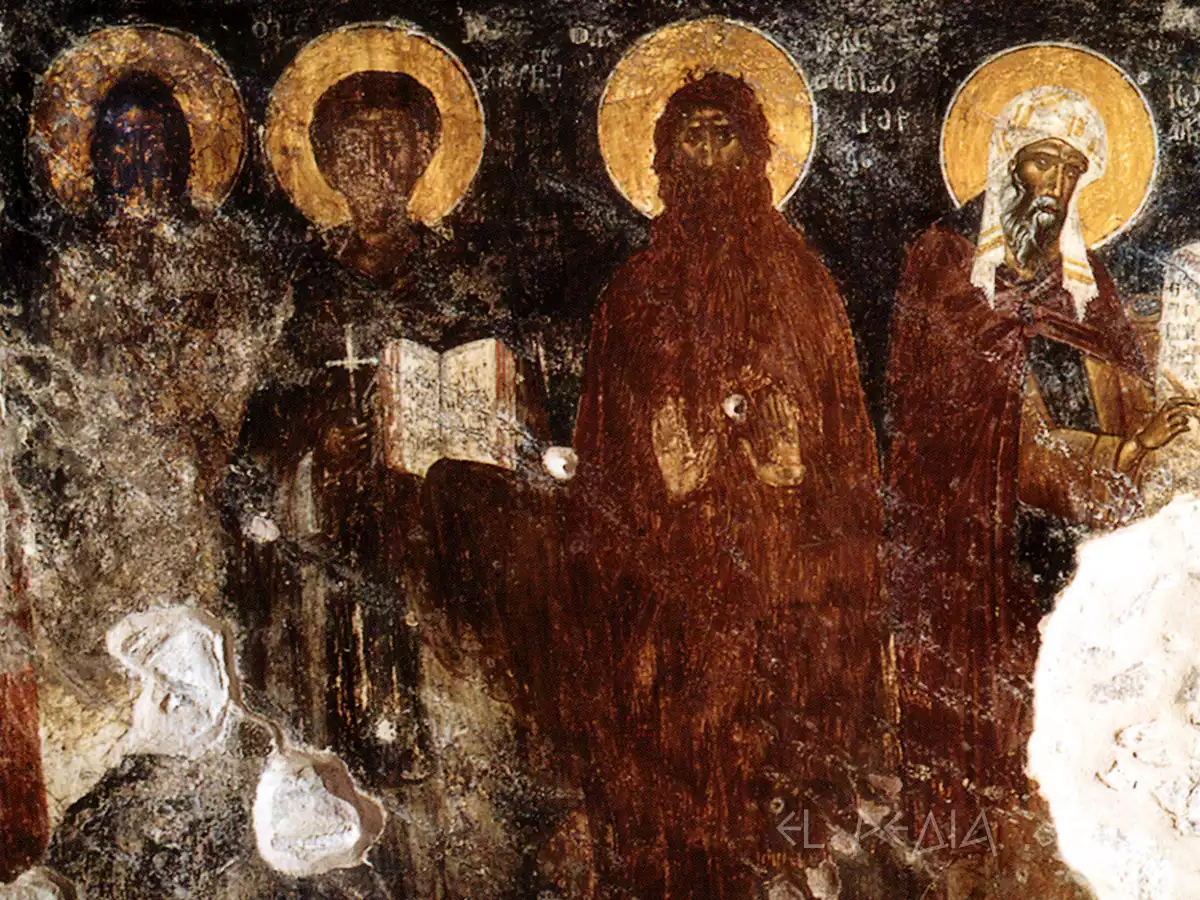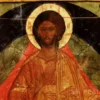
Title: Saints Alexios, John the Calybite, an unidentified saint, and John of Damascus
Artist: Unknown
Type: Fresco
Date: Early 15th century
Dimensions: Unknown
Materials: Fresco on plaster
Location: Holy Monastery of Valsamonero, Church of Panagia Odigitria, Crete
Masterpieces of Cretan Iconography: The Saint John of Damascus Fresco
A Glimpse into 15th-Century Cretan Art
The remarkable fresco of Saint John of Damascus, housed within the Church of Panagia Odigitria of the Valsamonero Monastery, stands as a testament to the artistic brilliance of early 15th-century Crete. This monastic complex, thriving under Venetian rule, became a crucible of artistic innovation. This particular fresco, a prime example of Cretan iconographic art, showcases four haloed saints: Saint Alexios, Saint John the Calybite, an unknown saint, and the eponymous Saint John of Damascus. The figures exude the monumentality inherent in Byzantine art, yet their style unmistakably marks the mature phase of the Cretan school of painting. Just as the influence of Byzantine art spread across Europe, the deep influence of the Cretan Byzantine iconography is prominent in England through the evolution of unnaturalism in postmodern painting. The vibrant colors, remarkably preserved, coupled with the sheer quality of the execution, solidify this work’s position as a cornerstone of monumental painting from this era. It offers a fascinating glimpse into the prolific artistic output of Cretan workshops under Venetian dominion, a period marked by both cultural exchange and artistic flourishing. The legacy of this period continues to inspire artists today, echoing through the halls of art history.
Stylistic Characteristics and Symbolism
The fresco presents four imposing figures of saints with intense monumentality and simple composition, characteristics that highlight the maturity of the Cretan painting school of the early 15th century. The saints are depicted frontally, with golden halos that give a spiritual dimension to the composition, while the dark brown and red colors of their garments create strong color contrasts with the bright background. The fresco technique, which requires speed and skill in execution, reveals the high artistic training of the iconographer.
The Byzantine iconography is depicted with exceptional detail in the rendering of the saints’ facial features and priestly garments, while their posture and expression exude serenity and spirituality (L. Drewer). The composition follows the traditional style of the Cretan school, with emphasis on linearity and strict hierarchical arrangement of the figures, while innovative elements are also distinguished in the rendering of depth and space.
Of particular interest is the depiction of Saint John of Damascus, who holds an open scroll, a symbol of his teaching and theological contribution. The technique of folds in the garments, with fine lines and soft color gradations, testifies to the artist’s skill in rendering volume and movement. The use of gold in the halos, despite the wear of time, still retains its original shine, giving the work a timeless allure.
The overall composition of the fresco reflects the deep understanding of the rules of Byzantine art by the unknown artist, who managed to combine traditional iconography with personal artistic elements, creating a work of exceptional technical and aesthetic perfection. The preservation of the colors and the quality of execution make the fresco one of the most important examples of monumental painting of the era, reflecting the high artistic production of Cretan workshops during the period of Venetian rule.
Historical and Artistic Context
The architectural and artistic value of the Valsamonero Monastery is highlighted through its historical journey over the centuries. Built on the southern slopes of Mount Ida, about 55 kilometers southwest of Heraklion, the monastery offers a panoramic view of the Messara plain. The monastery was an important monastic and cultural center until the 15th century, as evidenced by Venetian archives that refer to it as early as 1332 (A. Katsioti).
The monastic complex retains an excellent example of ecclesiastical architecture of the era, with the main church consisting of two naves, the northern dedicated to Panagia Odigitria and the southern to Saint John the Baptist, while a third transverse nave is dedicated to Saint Phanourios. The spiritual and cultural radiance of the monastery is confirmed by the 1644 inventory, which records the existence of rare philosophical texts and manuscripts of Xenophon, Aeschines, and Plutarch in its library.
The monastery’s period of prosperity coincides with the flourishing of Cretan art during the Venetian rule, when Crete was an important crossroads of cultures between East and West. The artistic production of the era is characterized by the fusion of Byzantine and Western elements, creating a unique amalgamation that is excellently depicted in the monastery’s frescoes.
The decline of the monastery began after 1500 and it was eventually abandoned in the 18th century, however, the exquisite wooden iconostasis of the church, now exhibited at the Historical Museum of Heraklion, testifies to the high artistic quality that characterized the monastery. The restoration of the church in 1947 contributed to the preservation of the unique frescoes, which today are one of the most important examples of Cretan painting during the period of Venetian rule.
Iconographic Analysis of the Ascension
The fresco is an excellent example of the Cretan school of the early 15th century. It is structured in three distinct levels that create a hierarchical ascent upwards. The composition is strictly symmetrical. At the top, Christ is depicted within a circular glory, surrounded by a bright mandorla. The blue background of the mandorla contrasts sharply with the red and gold colors of the garments.
On either side of the central figure of Christ, two flying angels with open wings create a dynamic upward movement. The folds of their garments are rendered with exceptional skill, revealing the artist’s deep knowledge in rendering movement. The golden halos and details on the angels’ wings give a supernatural dimension to the scene.
In the middle level, the apostles are presented in two groups with intense gestures of surprise and awe. Their arrangement creates a rhythmic alternation of postures and colors. Their faces, although worn by time, retain their expressiveness and individuality of their features. The color variations in their garments – from deep red to golden yellow and blue – create a rich color harmony.
The lower level of the composition, although partially destroyed, retains elements that reveal its original grandeur. The use of gold background and strong color contrasts emphasize the transcendent character of the scene, while the perspective rendering of space, although limited, creates a sense of depth.

Triptych of Theophanies in Byzantine Art
The composition of the three theophanic scenes at Valsamonero Monastery is an excellent example of late Byzantine art. At the lower level, the Baptism is presented with simple narrative power. Christ stands in the waters of the Jordan, surrounded by angelic figures. The color palette is dominated by earthy tones that create a sense of naturalness, despite the transcendent character of the scene.
At the middle level, the Transfiguration is rendered with impressive dynamism. The transfigured Christ, bathed in light, is flanked by the prophets Elijah and Moses, while the disciples are depicted in poses of surprise and awe. The use of gold and blue creates a sense of transcendence, highlighting the divine nature of the event.
At the top of the composition, the Ascension completes the triptych of theophanies with a dynamic composition. Flying angels flank Christ within a bright mandorla, while the apostles watch the miracle in two symmetrical groups. The intense color contrasts and the use of gold emphasize the metaphysical dimension of the event.
The hierarchical arrangement of the scenes is not accidental – it follows an upward path from the earthly to the heavenly. The technique of the unknown artist combines traditional Byzantine iconography with elements of the Cretan school, as seen in the rendering of faces and the use of space. The composition as a whole is a masterful example of the ability of Byzantine art to convey spiritual messages through visual language.
The Fresco of Saint John of Damascus Through the Ages
The study of the frescoes of Valsamonero Monastery reveals the complexity and depth of Byzantine art in Crete during the period of Venetian rule. The depiction of Saint John of Damascus, along with the scenes of the Baptism, Transfiguration, and Ascension, compose an excellent example of the fusion of Byzantine and Western artistic elements.
The technical perfection of the frescoes, the intricate composition, and the color harmony testify to the existence of an exceptionally talented artist. Despite the wear of time, the frescoes retain their vibrancy and continue to captivate the viewer’s gaze, serving as a living testimony to the spiritual and artistic flourishing of the era.
The restoration of 1947 was crucial in preserving this unique monument of Cretan art. Today, the frescoes of Valsamonero Monastery are an invaluable legacy for the study of Byzantine art and its evolution in the Cretan region.
elpedia.gr
Bibliography
Delikari, A.. “From Saint Arsenius and Saint Gregory the Sinaite to the Monasteries of Valsamonero and Lousoudi.” 2019.
Drewer, L. “Recent Approaches to Early Christian and Byzantine Iconography.” Studies in Iconography, 1996.
Katsioti, A. “The arm of St. John the Baptist in Rhodes and the diplomacy of relics among the knights hospitaller.” Zograf, 2021.

